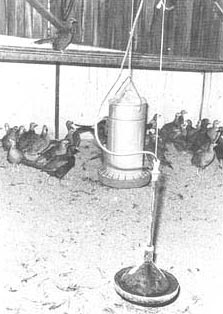
Pheasant housing
Housing pheasants
It has been the trend in Australia to house breeding stock in individual mating groups, as in the United Kingdom, and to a much lesser extent under range conditions, as in the United States.
The way breeding stock are housed is governed to a large extent by the size of the operation, the land available, and the type of market for which the pheasants are being reared.
Individual pen matings
Trials at the NSW Department of Primary Industries' former Agricultural Research Station at Seven Hills showed that with good husbandry practices, breeding birds can be housed under intensive conditions, similar to commercial poultry breeding stock.
- Individual pen matings allow the performance of each male, and the performance of the hens mated with that male, to be accurately assessed.
- The males are not able to fight each other, so fertility should be higher, and there will be fewer broken eggs.
- Individual pen matings are uneconomic and inefficient in a commercial pheasant meat operation, but they can be used in a breeding program to test the performance of certain strains of birds.
Range conditions
- Under range conditions, many pheasants can be mated at minimal cost. For range breeding, each bird needs about 2m2 of ground space.
- The site chosen should be a dry, well-drained, sheltered area — green pasture is not required.
- Make sure there is good cover where hens can shelter from overzealous cocks. Good cover will also encourage hens to lay eggs at central points, preventing them from being scattered over the yard.
- Shelters such as those illustrated below, should be strategically placed throughout the yard. The shelters shown have the approximate dimensions 1.5m × 1m. Regularly place a small amount of feed in front of each shelter to encourage birds to use them. One shelter for every 40 hens is quite sufficient, provided there is also a reasonable amount of natural grass or brush cover. If there is no natural cover, branches from trees can be placed throughout the yard. Suitable protective cover can also be provided by native foliage or from cultivated crops.

- If cultivated crops are sown, a mixture of millet and sorghum grains is ideal. The variety of the grains sown should be those recommended for the district. Alternate strips of canola (rape) can be sown with the above grain mixture. The canola will provide greenfeed picking for the pheasants.
- Dry stubble paddocks are also ideal for growing stock. Cut a section of the growth to give the pheasants access to moveable shelter sheds.
- Foxes, wild dogs and cats can be fenced out, but if this is impractical, discuss control measures with officers from NSW Department of Primary Industries or Local Land Services.
- The only practical way to prevent hawks attacking pheasants is to cover the pens with wire netting or lightweight plastic mesh.
- A disadvantage of range breeding is that some eggs will be laid in places other than the set nesting areas, and these can be missed during egg collection. The large area makes egg collection a more difficult and more frequent job than with other systems.
Intensive housing
Where breeders are housed intensively, skillion-roofed buildings are ideal. Place wood shavings on the floor to a depth of about 8 cm. Give each breeder about 0.5 m2 of floor space, and house no more than 50 breeders in one shed.

The photo at right shows birds housed intensively on litter. Note the perches provided for the hens, and the hanging tube feeder and cone-shaped drinker.
- In each intensive breeding house, provide a shelter (similar to the type suggested for range breeders) and a few suitable bushy tree branches. It is also advisable to run three perches 40 cm apart, along either the back or side of the building. This will provide additional shelter where hens can get away from a cock if they do not wish to mate.
- Where breeder birds are housed under intensive conditions, it is essential that they be mated at least 4 weeks before the breeding season starts, otherwise it becomes virtually impossible to get the birds to settle down — cocks will be injured through fighting, less dominant males will not be allowed to mate, and fertility will be low.
- During bad weather, conditions in an intensive house can be controlled to a large extent by the use of blinds or shutters.
- Artificial lights can be installed to help maintain, control and adjust peak egg production, giving a much greater overall control of the breeding flock than under range conditions.
- Egg collection is easier.
- More accurate flock performance records can be kept. The records can include such factors as feed consumption, which should be lower than under range conditions due to better temperature control and the absence of wild birds and rodents.

